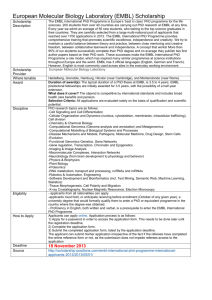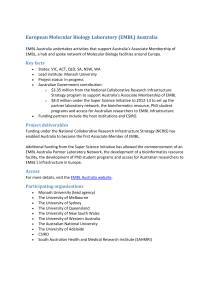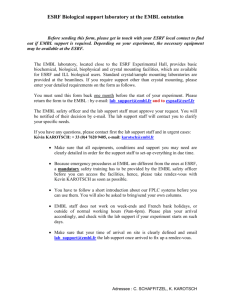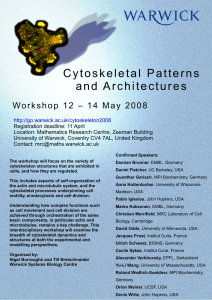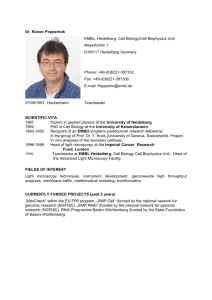International h Programme EMBL
advertisement
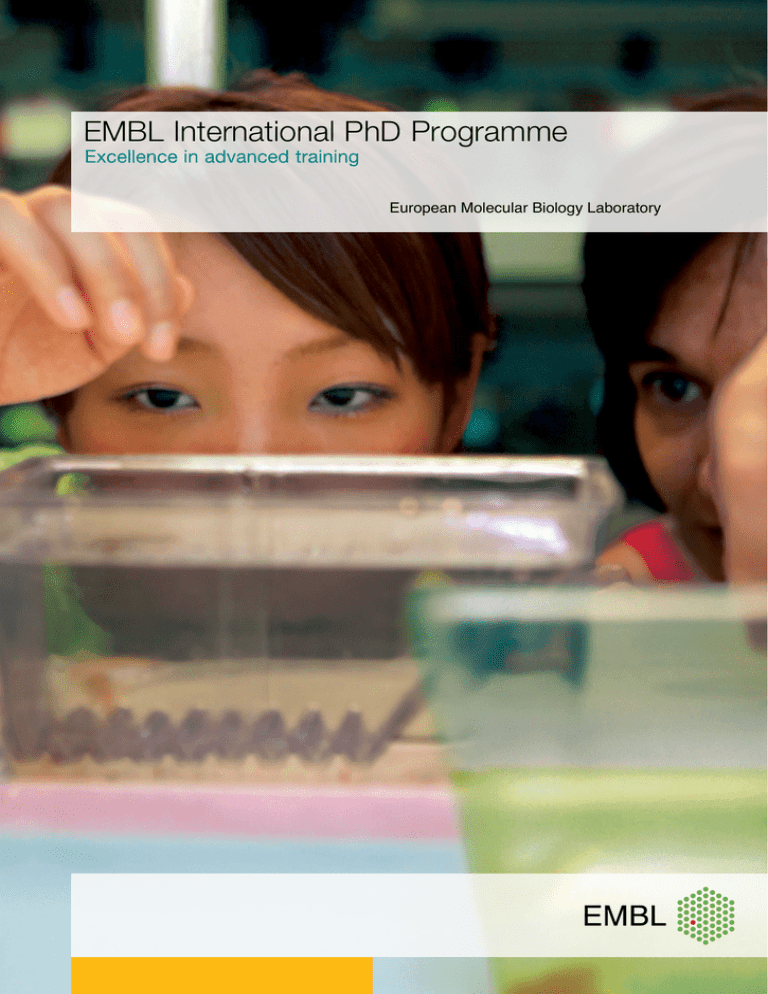
EMBL International PhD Programme Excellence in advanced training European Molecular Biology Laboratory Table of contents Welcome to the EMBL International PhD Programme Freedom for your independent spirit 6 What’s the best thing about doing your PhD at EMBL? EMBL research units EMBL sites 9 12 17 Our partner universities 19 A quick guide to the programme EMBL Heidelberg, Germany 4 20 EMBL-EBI, Hinxton, UK EMBL Grenoble, France EMBL Hamburg, Germany EMBL Monterotondo, Italy 3 Welcome to the EMBL International PhD Programme Unique in the world and waiting for you The years you spend as a PhD student play a pivotal role in your career as a scientist. The personal friendships and professional networks you make during this time, as well as the spirit of doing science that you encounter during your PhD, will shape the rest of your working life. Clearly, a successful PhD project will also open doors that may otherwise be difficult to step through. Doing science ‘the EMBL style’ means that you work at the cutting edge of science in a laboratory that has been ranked as the top non-US research institution in the world*. Our research projects are interdisciplinary and offer exciting opportunities for biologists, chemists, physicists, computer scientists, mathematicians and medical graduates who want to pursue a PhD in the molecular life sciences. Do you want to work in an international environment and in small groups with close contact to mentors? Collaboration and collegiality are hallmarks of the successful and fun EMBL culture. Whether you are looking for a friendly lab with open doors or a powerful scientific network, EMBL offers both. Helke Hillebrand, Dean of Graduate Studies, and Meriam Bezohra and Matija Grgurinovic, Administrators of the EMBL International PhD Programme 4 In addition to hosting open and interactive research groups and providing state-of-the-art equipment, EMBL is a hub for the best scientists in the world. Its seminar programme is matched by few. We are committed to providing a fine balance between carefully mentoring students and fostering early independence. Our students are not only active researchers, but they also take part in many other initiatives: they independently organise the acclaimed EMBL PhD Student Symposia, participate in Science and Society debates and meetings, and relax with the many musical, sports and social activities available at EMBL. Our students also have the privilege of exploring and benefiting from the enriching environments of EMBL’s five sites, located in Germany, Italy, France and the UK. As EMBL students, you are ambassadors of your culture and country to EMBL, and of EMBL to your home country. The EMBL International PhD Programme is also unique in the way its students obtain their PhD degree. We have established partnerships with some of the best universities across Europe to award joint PhD degrees with EMBL. Consequently, you may obtain your degree from either one of EMBL’s partner universities or from a national university of your choice. We invite you to apply to become an active member of the ‘EMBL culture’, so please read on. We are committed to making these most valuable years of yours a success. Helke Hillebrand * ISI Science Indicator, World Rankings in Molecular Biology and Genetics, 1997 – 2007. “EMBL’s International PhD Programme is a key part of the institute. The students create a youthful, dynamic atmosphere in the lab and we give them the resources and help they need to succeed.” Iain Mattaj, EMBL Director General 240 students are currently enrolled in the programme 5 Freedom for your independent spirit 6 Imagine a career that takes you anywhere you want to go. Where you can focus on bold questions whose answers will shape the future of science. This is a PhD in molecular biology, a frontier wideopen for discovery, which offers young people from many disciplines wonderful career opportunities all over the world. Choosing the right career path is not easy. As you finish your undergraduate degree, you will likely find yourself facing many opportunities. A PhD is one option that stands out above the rest. It allows you to develop your independent scientific thinking, exercise your creativity, solve fundamental biological problems and surround yourself with likeminded colleagues and advisors. Choosing where to do your PhD degree is another important decision. Many factors come into play when you look for an institution. EMBL’s excellent resources and solid funding mean that you have the security to focus on your project. The lack of barriers between research units gives you a chance to collaborate with scientists from different disciplines, bringing out the best ideas and solutions to problems. An ‘open door’ policy gives you the chance to discuss projects and the challenges that are invariably associated with novel research. And camaraderie among your colleagues gives you the support you need to become an independent thinker and researcher. The EMBL International PhD Programme provides the ideal environment for ambitious students. Our resources, facilities, and staff are second to none. We continually strive to make this the best possible place for creative PhD students. Over the course of your studies, you will develop new insights, mature into a modern researcher and make important contributions to the life sciences. 150 applicants (out of ~2000) are invited for an interview every year 7 EMBL Graduates Modelling spindle positioning in the C. elegans embryo Taking science from the bench to society Cleopatra Kozlowski Giuseppe Testa Nationality: British/Japanese/Polish Graduated from EMBL in 2007. Cleo is now a Scientist at Genentech Inc, a large biotech company in San Francisco, California Nationality: Italian Graduated from EMBL in 2001. Giuseppe is now at the Laboratory of Stem Cell Epigenetics, European Institute of Oncology, Milan. He is a recipient of the Branco Weiss Fellowship ‘Society in Science’. “Being among people in the pure pursuit of knowledge is very important in learning to ask the right questions.” “EMBL unleashes your scientific curiosity and encourages you to take science beyond the bench.” As a child, Cleo was always curious about how things worked – “especially the weird things,” she says. “What first motivated me to study biology may have been the images of a two-headed fly in a first year molecular biology course about the role of Hox genes in development.” During his studies at medical school in Perugia, Italy, Giuseppe became increasingly fascinated with molecular biology – seeing it as the real future of medicine. He knew that EMBL was the place he wanted to be. “When EMBL called me for an interview, I didn’t hesitate,” he says. While studying at Cambridge University in the UK, Cleo decided that EMBL was the place to continue building her scientific career, so she applied to the Cell Biology and Biophysics Unit. There she pursued her PhD in the modelling of spindle positioning in the C. elegans embryo using computer simulations. “Although I had worked as a summer student and undergraduate in several institutions, EMBL was the first place where I found everybody – from masters students to the heads of labs – to be truly dedicated to basic science,” she says. “It was very motivating to be among an international group of people who are united by their interest in understanding life. For a PhD student, being among people in the pure pursuit of knowledge is very important in learning to ask the right questions. That’s why I’m very glad that I was at EMBL at the PhD stage of my scientific career.” At EMBL, Giuseppe enjoyed the vibrant mix of languages, cultures and people. “You feel really immersed in Europe at EMBL, and the friendships that you build during your PhD stay with you long after you leave the lab,” he says. Cleo also enjoyed her EMBL experience outside the lab. “As a ‘hybrid’ myself (I’m half Japanese, half Polish), I felt really comfortable in the international environment,” she says. “I also truly enjoyed my time in Heidelberg, and visiting the surrounding beautiful German villages.” 8 As a PhD student at EMBL, Giuseppe felt encouraged to pursue his intellectual curiosity and push boundaries. His research focused on establishing a mouse model of an acute form of leukaemia and led to the breakthrough development of a new approach for the engineering of the mouse genome. This project gave him the tools with which to pursue his current work on the differentiation of embryonic stem cells. Giuseppe also took an active role in the laboratory’s ‘Science and Society’ activities. He helped to open the dialogue between science and the public, and pursued the social implications of biotechnology through reading clubs, study sessions, conferences and workshops, while doing postdoctoral research in Dresden. This involvement led him to start a similar initiative while in Dresden, where he chaired the Dresden Forum on Science and Society at the Max Planck Institute of Molecular Cell Biology and Genetics. For his interdisciplinary project on the legal and ethical framing of cloning and stem cell research in different political cultures, he was awarded the prestigious Branco Weiss Fellowship ‘Society in Science’ in 2003. Straight from the students: What’s the best thing about doing your PhD at EMBL? “The Predoc course let me experience various relevant fields, from concepts in biology to computer programming” – Jun Hee Kang, EMBL PhD student from South Korea. Every year, EMBL accepts about 60 students into its International PhD Programme. These students will work at any of the EMBL sites, taking up positions in Hamburg, Grenoble, Heidelberg, Hinxton, or Monterotondo. But before they start working in their labs, the students are brought together in Heidelberg for the two-month Core Course in Molecular Biology to get an overview of the research at EMBL and to hear about new areas of science. Students learn where to go if they need help on a certain problem or technique during their PhD. They also participate in practical activities, journal clubs and discussions. Many of our students come from physics, mathematics and chemistry backgrounds and the course gives them a good idea of problems facing molecular biologists. Students are guaranteed close contact with EMBL group leaders, giving them a chance to learn more about their research and expertise. And perhaps most importantly, the students get to know each other during the courses and in the many social events that are organised for and by the new predocs. EMBL students have a wide social network in the lab, which often leads to fruitful scientific collaborations. “What struck me is that people actually listen to what you have to say” – José Afonso Assunçao, EMBL PhD student from Portugal. When it comes to science and research, there are few molecular biology institutes that can be compared to EMBL. The fact that many group leaders are also beginning their scientific careers and only stay at EMBL for a limited number of years guarantees a young, dynamic and informal environment. This open and collegial atmosphere encourages students to share their opinions and ideas. They feel that what they say really matters. Students are given guidance and supervision by group leaders, but are encouraged to look independently for expertise and collaborative projects in their area of research. Students are encouraged to take their projects in the direction that interests them most. “The vast network of collaborations creates a hotbed for creative science” – Hernando Martínez, EMBL PhD student from Spain. EMBL gives students exposure to the most exciting research in molecular biology. With experts in the fields of bioinformatics, gene expression, cell biology 9 Straight from the students: What’s the best thing about doing your PhD at EMBL? and biophysics, developmental biology, structural and computational biology and mouse biology, students have a wealth of knowledge from which to draw. Because the institution has a training mentality, EMBL scientists are easily reachable to discuss scientific projects, hear about a student’s work or develop collaborative projects. Doors are always open, questions welcome and help available when you need it. The relaxed atmosphere in the lab enables easy communication with scientists and provides many opportunities to make connections and establish collaborations. “Organising the PhD symposium broadened my knowledge and offered inspiration” – Alex De Marco, EMBL PhD student from Italy. PhD students are also given a very unique opportunity – to independently organise their own conference. The EMBL International PhD Symposium is organised by students from beginning to end. They decide the topic, select and invite the speakers, and secure funding. Previous symposia have dealt with a variety of interdisciplinary themes, such as ‘From Genes to Thoughts’, ‘Evolution’ and ‘Design of Life: Learning from Nature’. Every year, this event brings together hundreds of students and the feedback from the participants and the speakers has been very enthusiastic. “Life at EMBL doesn’t stop at the bench; it’s fun to check out some of the clubs on offer” – Lucía Herrera, EMBL PhD student from Guatemala. EMBL’s Staff Association generously supports different activities outside the lab. The music club organises concerts for EMBL scientists who enjoy playing or singing to share their music with others. The various sports clubs, including diving, climbing 45 different nationalities are currently represented by the student body 10 and waterskiing, offer special rates and even trips to exotic locations. Throughout the year, parties bring all the departments together to enjoy the mix of cultures at EMBL. In January, the Scots throw a traditional ‘Burns’ night’, the Germans celebrate ‘Oktoberfest’ in the autumn and the Greek community has been known to bring all nationalities together for great food and traditional dancing. “All the EMBL sites offer superb scenery and access to great European cities” – Romain Gibeaux, EMBL PhD student from France. Whether it be skiing on the local hills in Grenoble, enjoying the classic student town of Cambridge, biking through the forest in Heidelberg, strolling along the famous Hamburg harbour, or touring around Rome, students get to know and enjoy the beautiful European locations of EMBL. EMBL Graduates Opening doors to a career in science A fusion of physics and biology for a developmental blueprint Marina Ramirez-Alvarado Philipp Keller Nationality: Mexican Marina was the first student representative at EMBL and graduated in 1998. She is now an Assistant Professor at the Mayo Clinic in Rochester, Minnesota, USA. Nationality: German Philipp graduated from EMBL in 2009 and is now a fellow at Howard Hughes Medical Institute’s Janelia Farm Research Campus. “Doing my PhD at EMBL opened every door for my career.” “It’s much more important to think about what you really enjoy doing, rather than making a decision based on what you might or might not achieve.” Now an Assistant Professor at the Mayo Clinic in Minnesota, Marina is studying diseases associated with misfolded proteins. Her interest in protein structure began at EMBL. She was drawn to the lab by its world-class facilities, interdisciplinary environment and international staff. “EMBL trained me to exercise my creativity and to believe in what I do. It gave me the confidence to set my goals high and the knowledge to reach those goals.” Marina’s PhD work at EMBL involved the design and characterisation of different peptides using a variety of spectroscopy. The work of Marina and her colleagues was an important first step towards understanding the beta-sheet structure of proteins, which plays a key role in Alzheimer’s and other diseases. After finishing her PhD, Marina went to Yale University to do postdoctoral research – to study how infectious proteins form very stable beta-sheet structures called amyloid. At the Mayo Clinic, she is studying the molecular mechanisms underlying a rare amyloid disease called light chain amyloidosis. In addition to her work at the lab bench, Marina enjoys teaching courses in molecular biology to graduate students at the Mayo Clinic. Philipp started out as a physicist, but found himself becoming interested in a fusion of biology and physics after getting involved in practicals at Heidelberg’s Max Planck Institute for Medical Research. “When I was deciding where to do my PhD, someone suggested that I check out what the groups at EMBL were doing. I looked at the website and was really interested in EMBL’s multidisciplinary projects – I found they were exactly the kind of topics I wanted to pursue.” During his PhD, Philipp achieved a groundbreaking result – the first complete developmental ‘blueprint’ of a vertebrate – with his reconstruction of zebrafish embryonic development using a Digital Scanned Laser Light Sheet Microscope. The resulting video gained huge interest from the media and was named one of the top ten ‘breakthroughs of 2008’ by Science. “The technology we developed at EMBL was the key to producing the data needed to achieve this,” he says. “But from a scientific point of view, all my projects were just as invaluable in helping me develop my skills.” Philipp was impressed by the possibilities offered at EMBL. “I pursued several projects during my PhD, which allowed me to explore entirely different areas of biology and find out for myself what I might want to continue with in the future,” he says. “The amazing thing about EMBL is that you can just go to a lab next door or down the hall and start a collaboration in whatever area interests you. It’s also great to come to EMBL at the beginning of your career and to be exposed early on to all the different topics, and to be involved in research at the cutting edge of science.” 11 EMBL Research Units EMBL science covers a wide spectrum of themes in basic research. The focus ranges from the study of sequences and structures of single molecules to their functions in cell structures and behaviour and their influence on the development and lives of organisms. Increasingly, many research groups are combining their multidisciplinary skills in a systems biology approach. Research is organised into units at the five EMBL sites. Technical and support groups interact heavily with, and participate 12 in, the work of researchers. For example, EMBL’s pioneering role in the field of bioinformatics has led to a fruitful integration of computational scientists with those that work at the bench. And the staff of the core facilities develop new methods as they help users learn to use advanced instruments and techniques. Recent years have seen a dramatic increase in interdisciplinarity within molecular biology: researchers looking at embryonic development are rapidly learning about the biochemical and cellular functions of key genes; data from physical measurements lead to mathematical simulations that can suggest experiments in cells and organisms; gene expression studies are allowing scientists to create new hypotheses about ‘missing links’ in evolution. EMBL has created scientific ‘centres’ to further encourage such cross-disciplinary work. The following summarises the activities of the research units at EMBL. To find out more about specific research projects, visit www.embl.de/research_general. 60 students are accepted into the programme each year EMBL-EBI, Hinxton, UK Bioinformatics The EBI is probably best known worldwide for its provision of biological information and bioinformatics services. However, about 20% of the institute is devoted to investigator-led research using computational approaches to unravel the secrets of life. Although we are united in using computers, the biological questions we address and the algorithms we develop and use are very diverse. We explore biological questions spanning genome evolution, transcriptional regulation and systems modelling of basic biological processes and disease. Janet Thornton Director Rolf Apweiler Joint Associate Director Ewan Birney Joint Associate Director EMBL Heidelberg, Germany Jan Ellenberg Head of Unit Research at EBI is carried out both in groups devoted solely to research and in some of the larger service teams that have associated research activities. All researchers have computational approaches as their major focus, but most also collaborate closely with experimentalists and often generate experimental data themselves. Our research is highly collaborative within EMBL as well as with many external colleagues. We are highly interdisciplinary; our faculty comprises scientists who originally trained in biology, physics, chemistry, engineering, medicine or mathematics. We develop novel algorithms and protocols for handling data, such as checking the quality of the data; interpret data and integrate data to generate new knowledge. We use this information to develop novel hypotheses about the basic molecular processes of life. Cell Biology and Biophysics In this Unit, physicists and chemists work closely with biologists to elucidate the fundamental rules that govern dynamic cell organisation and function, while developing new instruments and technologies in order to reach this ambitious goal. Novel developments in microscopy, computer simulations and chemical biology-based probes are a particular strength. New correlative light/electron and superresolution imaging methods, as well as mechanistic biochemistry allow us to directly interface between cell and structural biology to understand molecular mechanisms. On the other hand, advances in live microscopy methods, now allow us to carry out cell biology in developing organisms to understand how cell organisation and collective cell behaviour leads to organ formation. 13 Developmental Biology EMBL Heidelberg, Germany The development of living organisms requires precise coordination of all basic cellular processes, in space and time. Groups in the Developmental Biology Unit seek to elucidate the principles, mechanisms and dynamics of fundamental developmental events. Using animal and plant models, research in the Unit integrates numerous complementary approaches to understand how cellular and morphological processes are coordinated and evolve to shape and maintain living organisms in their environment. Research includes understanding the regulatory mechanisms of developmental cellular processes; studying simple marine organisms to understand the evolution of our central nervous system; elucidating the temporal organisation of emybronic development; investigating how the machinery that controls trafficking within cells is reorganised as tissue forms; understanding patterning in plant development; and studying both normal development and its deviations in disease. Genome Biology Anne Ephrussi Head of Unit EMBL Heidelberg, Germany The genome encodes the genetic blueprint that coordinates all cellular processes, which ultimately give rise to phenotype. The Genome Biology Unit takes a systems biology approach to unravel these complex processes at all scales, integrating wet-lab and computational approaches. A notable strength of the Unit is its ability to address questions at different scales, ranging from detailed mechanistic studies (using biochemistry, genetics, microfluidics and chemistry) to genome-wide studies (using functional genomic, proteomic and computational approaches), often with developing new enabling technologies. The synergy between computational and wet-lab groups provides a very interactive and collaborative environment to yield unprecedented insights into how genetic information is ‘read’ and mediates phenotype through molecular networks. Mouse Biology Dynamic partnerships and exchanges with other international academic research and clinical centres, and participation in multiple EU-wide mouse research and informatics initiatives, are integral parts of EMBL Monterotondo’s discovery process into genetics and genomics, cell biology and pathology. The continued refinement of genetic and epigenetic perturbations of cellular and physiological functions through the use of conditional and other increasingly finely engineered mouse mutations at EMBL Monterotondo is generating ever more accurate models of human disease and multigenic disorders. Research groups use these powerful tools to investigate wide-ranging aspects of mammalian biology, including gene expression, development and differentiation, cancer and regeneration, behaviour and sensory perception. A state-of-the-art animal facility provides a full range of mouse transgenic and gene knock-out production, embryo rederivation and cryopreservation services, and a fully phenotyping suite. 14 Eileen Furlong Head of Unit Lars Steinmetz Associate Head of Unit EMBL Monterotondo, Italy Philip Avner Head of EMBL Monterotondo Structural and Computational Biology Peer Bork Joint Head of Unit Christoph Müller Joint Head of Unit Stephen Cusack Head of EMBL Grenoble Matthias Wilmanns Head of EMBL Hamburg Structural and computational biology research at EMBL aims to bridge the world of small biological entities (proteins, nucleic acids) to the world of larger ones (cells and organisms). The Heidelberg Structural and Computational Biology Unit (SCB) pursues an ambitious research programme with a strong basis in integrated structural systems biology and a far-reaching computational component that bridges various areas of biology. A wide spectrum of expertise allows the Unit to tackle problems at different ranges of spatial resolution, connecting atomic structures and dynamic information obtained by X-ray crystallography and NMR with medium-range resolution from single particle electron microscopy, and cellular imaging obtained by electron tomography and light microscopy. Dedicated large-scale biochemistry, proteomics, chemical biology, biophysics, and cell biology approaches complement the structural biology activities and, in conjunction with a wide range of innovative computational biology activities, are integrated into a comprehensive description of biological function. EMBL Grenoble has a very active research programme in structural biology of cellular processes (for example, transcription, translation, RNA quality control, viral replication, innate immunity, small non-coding RNAs). Research is facilitated by the wide range of techniques (molecular biology, biochemistry, cryo-electron microscopy and tomography, high-throughput expression and crystallisation robotics, neutron scattering, NMR, X-ray crystallography and small angle X-ray scattering (SAXS)) available through the Partnership for Structural Biology which links the European Synchrotron Radiation Facility (ESRF), Institut Laue Langevin (ILL) and local French structural biology institutes. The outstation also develops new technologies for high-throughput crystallisation and makes significant contributions to the instrumentation and MX and SAXS services at the ESRF, and is part of an international research unit focused on virus-host cell Interactions with the city’s University Joseph Fourier and the CNRS as partners. Activities at EMBL Hamburg focus on state-of-the-art structural biology methods using synchrotron radiation, combining cutting-edge technology with an ambitious research programme for structures of multifunctional proteins and protein complexes of biomedical relevance. Present research interests include cell surface receptors, protein assemblies in muscle cells, protein kinases, protein translocation into peroxisomes, and several projects relating to tuberculosis. Common to all projects is to make optimum use of on-site high-brilliance synchrotron radiation and to explore novel opportunities of the X-ray Free Electron Laser. Beyond the tools in structural biology that are available on-site, EMBL Hamburg groups are engaged in many interdisciplinary collaborations with colleagues from other EMBL units. Hamburg also has a well-established record for the development of novel, innovative technologies in structural biology. 15 Hamburg Hinxton Heidelberg Grenoble Monterotondo Associate Member State Argentina 16 Associate Member State Australia EMBL sites EMBL member states: Austria, Belgium, Croatia, the Czech Republic, Denmark, Finland, France, Germany, Greece, Iceland, Ireland, Israel, Italy, Luxembourg, the Netherlands, Norway, Portugal, Spain, Sweden, Switzerland and the United Kingdom EMBL Heidelberg Associate member states: Argentina, Australia The city of Hamburg, Germany offers a wide spectrum of activities from art exhibitions, music, theatres, sports and the ambience of a large city. You find water almost everywhere, at the historical port, the inner-city lake Alster, the river Elbe and the nearby North and Baltic seas. EMBL Hamburg, which shares a campus with the German Synchrotron Research Centre (DESY), operates three synchrotron radiation beamlines and offers world-leading facilities and expertise to the research community. The new facilities at the PETRA III storage ring opened in 2012. Prospective member states: Hungary, Poland, Slovakia The main Laboratory of EMBL is nestled in the forested hills above Heidelberg, Germany. ~1000 staff members work closely in its integrated research units, and the central service facilities and administration of EMBL are also located here. The large number of university students contribute to Heidelberg’s young and dynamic flair. The narrow, picturesque streets of the Old Town are filled with theatres, cinemas and countless restaurants and pubs. The famous Schloss (castle) is majestically set above the centre of the city. EMBL Hamburg EMBL Grenoble This EMBL outstation shares a campus with the Institut Laue Langevin (ILL) and the European Synchrotron Radiation Facility (ESRF) in Grenoble, France. Situated in the heart of the Alpine mountain range, Grenoble is the capital of the French Alps and a lively university town, with students representing one-tenth of the population. Residents enjoy activities such as hiking, mountain climbing, skiing and snowboarding, rafting, kayaking, and canoeing as well as a wide variety of cultural activities in the city. EMBL-EBI Hinxton The European Bioinformatics Institute (EMBL-EBI) is located on the Wellcome Trust Genome Campus in Hinxton, near Cambridge (UK). The campus provides an exceptionally stimulating environment in which to conduct top-quality research, and is regularly visited by some of the greatest minds in the biomedical sciences. The EBI is housed in modern buildings in a beautiful rural setting and is only a stone’s throw from the historic university town of Cambridge, where ancient college buildings rub shoulders with peaceful meadows. As one of the world’s most important academic centres for almost 800 years, Cambridge has an unrivalled reputation for scientific achievement. Its strength in pure science has spilled over to the region’s commercial sector, which boasts one of the most mature and commercially successful biotechnology clusters in Europe. EMBL Monterotondo The EMBL Monterotondo campus in Italy is situated in a green park, 20 km north of central Rome. The Eternal City is an easy train ride away, and the nearby Lazio countryside features medieval hill towns, spectacular mountain terrain and lakes for hiking, biking, skiing and swimming. EMBL shares the Monterotondo campus with Italian national research groups (IBC-CNR) and the European Mouse Mutant Archive (EMMA). 17 EMBL Graduates The EMBL philosophy: open doors and collaboration A chance to inspire science teaching in schools Antonio J. Giraldez Elena Seiradake Nationality: Spanish Antonio graduated from EMBL in 2002 and stayed as a bridging postdoc until February 2003. He’s now an assistant professor at Yale University in New Haven, Connecticut. Nationality: Greek Elena graduated from EMBL in 2006 and was the first EMBL recipient of a Marie Curie E-STAR fellowship to defend her thesis. She is now a postdoc in the Division of Structural Biology at Oxford University’s Wellcome Trust Centre for Human Genetics. “I know of no other institute quite as special as EMBL, both as a place to do science and a place to have fun.” “From the PhD interviews onwards you’re exposed to dozens of different nationalities at EMBL,” says Antonio, who studies how RNAs shape embryo development. “Arriving as a student in a foreign country – something that could be intimidating – becomes a fantastic experience, because fifty other students are in the same boat. It’s the perfect recipe for firm friendships and camaraderie, as well as a great breeding ground for scientific collaborations and networks.” “The things that make EMBL such a great place are the excellent scientific facilities and the open minded, dynamic and multicultural people.” As a recipient of a Marie Curie Early-Stage Training in Advanced Life Science Research (E-STAR) fellowship, Elena was offered opportunities to learn extra skills to complement her scientific research. One such activity was a ‘Learning Lab’ for teachers, organised by EMBL’s dedicated education facility, the European Learning Laboratory for the Life Sciences (ELLS). Antonio spent a summer internship in an EMBL lab before applying to the PhD programme. “I found myself in one of the scientific centres of the world,” he says. “I got exposure to amazing science both from my colleagues and from the numerous lectures and courses run by world leaders in their fields.” “The teachers were very eager to learn about our work, and this really increased my regard for our own research,” says Elena. The experience of communicating science to non-researchers was so positive that she became involved in other such events, including Grenoble’s Science Teaching Festival. Antonio admires the tremendous motivation of everyone at EMBL. “After leaving, I came to realise the wisdom of those that played a fundamental role in shaping the EMBL philosophy of open doors, communication and collaboration,” he says. “Most importantly, I owe some of my best friends, and even my wife, to my time at EMBL.” When not communicating science, she found her work at the bench very rewarding too. “Besides giving me an exciting project, my supervisor found the perfect balance between giving advice and allowing freedom in the lab,” she says. “The freedom motivated me by making me feel responsible for my project, but whenever I got stuck I could always ask him for help.” 9 weeks are spent in Heidelberg during the Core Course in Molecular Biology 18 Our Partner Universities Both, EMBL and its International PhD Programme strive to contribute to the European academic landscape by establishing bonds with national education systems. We are committed to meeting the highest standards for the education and training of PhD students in the molecular life sciences and to seeking innovative solutions to further improvements. In its mission, the EMBL International PhD Programme sees itself as a strong and loyal partner of the universities in its member states. Based on EMBL’s authority to grant PhD degrees, we have initiated a Partnership Programme with some of the most highly respected universities in Europe. An important aspect of this initiative is that EMBL PhD students can obtain joint PhD degrees from us together with our partners. Our long-term ambition is that these partnerships, which are currently bilateral between EMBL and specific universities, will grow into a network for the optimal recruitment, training and career support of its PhD students. We are happy that the universities listed below have already become EMBL’s partner universities, and look forward to more universities joining in the future. Please see www.embl.org/phdprogramme for the latest update. EMBL International PhD Programme Partner Universities (as of December 2014): Belgium Katholieke Universiteit Leuven Croatia University of Zagreb Finland University of Helsinki Åbo Akademi University Turku University France Université de Grenoble Université Louis Pasteur de Strasbourg Université Paris Diderot Germany Ruprecht-Karls-University of Heidelberg Ludwig-Maximilians University of Munich Universitätsklinikum HamburgEppendorf Greece University of Crete Hungary Eötvös Loránd University Iceland University of Iceland Ireland University College Cork Italy University of Milano Netherlands Radboud University Nijmegen Norway University of Bergen University of Oslo Portugal Universidade Nova de Lisboa Universidade de Lisboa Spain Universidad Autónoma de Madrid United Kingdom University of Dundee, Scotland 19 Quick guide to the programme 20 Are only students from member states eligible to apply? What about students from non-member states? Highly qualified students of all nationalities may apply for the EMBL International PhD Programme (EIPP). Can I apply for the PhD Programme before I receive my degree? Yes. Applications can be submitted before obtaining the degree, though you must be scheduled to complete your degree by the start of your contract at EMBL. What type of degree will I need when I apply? PhD applicants must hold, or anticipate receiving before enrolment, a university degree that would formally qualify them to enter a PhD or equivalent programme in the country where the degree was initially obtained. All applications are evaluated solely on the basis of qualification and scientific potential. Do I need to choose and contact a specific group leader with whom I want to work before applying to the EMBL International PhD Programme? No. It is neither necessary nor recommended to contact group leaders individually. Students wishing to apply for the EMBL International PhD Programme will find all necessary information regarding research projects of the various units on the EMBL website. On the application form, the student may choose one or two units as well as selecting from a list of research keywords and, if invited, is interviewed by all group leaders of either or both of the units. Note that not all group leaders accept students each year. When do I need to submit my application form? The application deadlines and all relevant information are published well in advance on the PhD Programme website (www.embl.org/ phdprogramme). Please note that the entire application procedure is online. There are two application rounds each year. What is the format of the interviews? Firstly, each candidate will be interviewed during the Initial Admission Assessment (IAA) interview. This is a 20 minutes pass interview and is the prerequisite to be eligible to join the EIPP. General knowledge questions will be asked taking the applicant’s background into account. Everybody who passes this interview is, in principle, eligible to enter the EMBL International PhD Programme, and will be interviewed further in one-on-one discussions with group leaders from the chosen units. 25 is the average age of an incoming PhD student Will I receive feedback about my application even if I am not invited for an interview? The very large number of applications to the programme makes it impossible for us to give specific feedback regarding the merits of each application. However, our online application system allows us to offer something unique even to those applicants who are not invited for interview: the Shared Applicant Pool. A question on the application form asks whether the applicant would like his/her application to be made available to other interested colleagues, in case he/she cannot be admitted to the EMBL International PhD Programme. So, with the click of a button, our applicants are given the opportunity to be considered for PhD positions in an even larger group of top-quality research laboratories. These include our Partner Universities and other excellent research groups with whom EMBL has close ties. The effort of making a good application to the EMBL International PhD Programme can therefore bring extra benefits. If invited for interview will EMBL cover my travel expenses? EMBL covers reasonable travel expenses and will reimburse those during the interview week. All claims necessitate receipts. If I am accepted for the EMBL International PhD Programme, when can I start? Successful applicants can commence their PhD any time after the interviews and should ideally start by October at the latest of any given year. Starting dates are decided upon in agreement with the respective group leader. Do I need to register with a university before I start my contract? No. Students must register with a university during their first year in the EMBL International PhD Programme. Is there help with finding accommodation? Yes. EMBL has guesthouse apartments which can be rented for the first few months after your arrival, giving you time to find suitable accommodation. The EMBL housing service has apartments from local landlords on offer as well. How will I finance my PhD studies? EMBL provides a competitive stipend judged by international standards including broad health care benefits and pension access. Actual stipend rates are published on our webpage www.embl.org/ phdprogramme. 21 Quick guide to the programme I have my own funding. Does this guarantee a place in the programme? All applications are evaluated solely on basis of qualification and scientific potential. All invited candidates must successfully pass the interview procedure in order to be eligible. What is the predoc course and do all students have to take it? The predoc course is compulsory for all EMBL PhD students. This course, called the Core Course in Molecular Biology, is taught by EMBL faculty and is held at the beginning of the first academic year (October to December) at the main lab in Heidelberg. The course covers all scientific areas represented at EMBL and includes lectures, practicals and student seminars. Who will supervise and mentor me during my studies? In addition to the day-to-day supervision by a group leader, each EMBL PhD student has a Thesis Advisory Committee, consisting of the group leader and up to 22 three other advisors (typically one additional EMBL group leader from the same unit, one from a different unit and a non-EMBL scientist from the student’s university), who guide the student during thesis work. Within the first nine months, students prepare a written outline of their thesis project and discuss it with the committee. At the end of the second and third years, students write an annual report on their work, give a seminar, and discuss the report and seminar with their Thesis Advisory Committee. How is the PhD thesis evaluated? This will be affected by the requirements of the university at which you are registered. In general, the thesis is evaluated in terms of scholarly criteria by each member of a Thesis Examination Committee. One criterion is the likely acceptability of the thesis work for publication in international peer-reviewed journals. A decision is delivered by the Chair of the Thesis Examination Committee on the basis of the committee members’ written reports. What type of degree will I receive? In December 1997, in recognition of the high quality of its International PhD Programme, EMBL was granted the right to award its own PhD degrees. EMBL became the first international institution providing training in molecular biology in Europe with this capability. Currently, EMBL students obtain their degree from a national university or jointly with EMBL. How long does it take students to complete their PhD? Students enrolled in the EMBL International PhD Programme must complete their degrees within 3.5 to 4 years. Contact information For more information, please contact: EMBL International PhD Programme EMBL Meyerhofstraße 1 69117 Heidelberg Germany Tel. +49 6221 387 8896/8612 Fax +49 6221 387 400 www.embl.org predocs@embl.org 23 © EMBL 2014 EMBL member states are Austria, Belgium, Croatia, the Czech Republic, Denmark, Finland, France, Germany, Greece, Iceland, Ireland, Israel, Italy, Luxembourg, the Netherlands, Norway, Portugal, Spain, Sweden, Switzerland and the United Kingdom. Associate member states are Argentina and Australia. Prospective member states are Hungary, Poland and Slovakia.
